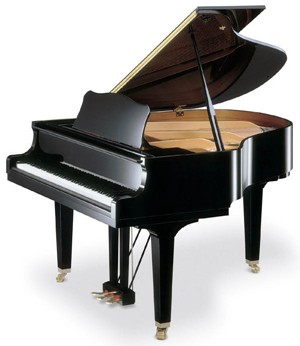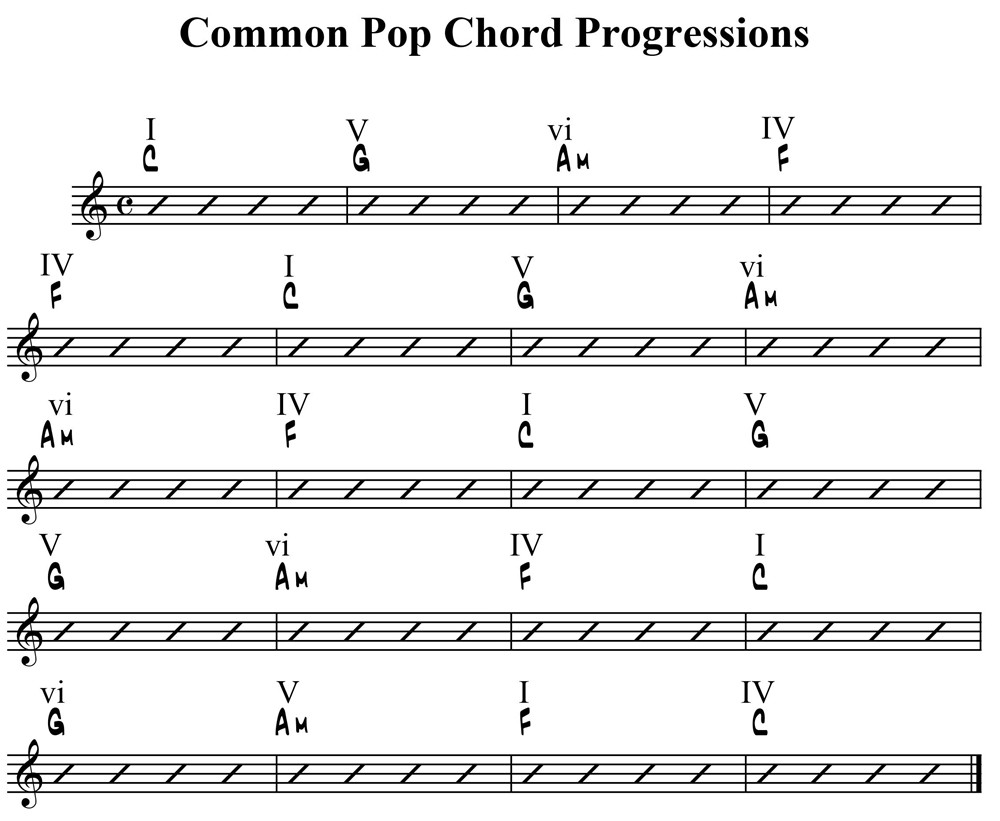1 What are chords?
2 Chord Basics
3 The Popular Song Form
4 The Four Chords of Pop Piano
5 The Type of Chords Used in Pop Songs
6 Chord Charts & Lead Sheets
7 Being the Rhythm Section of a Pop Song
8 My Final Thoughts
Playing pop songs on the piano is quite different from playing classical songs. There are differences in theory and style. This article focuses on how to play pop songs on the piano in the context of chords.
In order to play pop songs on the piano, you must have a reasonable knowledge of chord theory, the ability to read lead sheets or chord charts and some proficiency in playing piano rhythms.
What are chords?
A Chord is defined as three or more notes played in unison. Another definition of chords is harmony. Chords can be played by an instrument or sung by vocalists in a group. The most common chords are triads which are three note chords.
Just a quick note: Learning chords are how aspiring piano players learn to play piano at home and this article is everything you need to know about getting started.
Chord Basics
Triads are the most fundamental chords in music. They consist of the first, third and fifth tones of Major scale (or key) of music. Triads are also said to be the workhorses in music because they’re so common.

It’s very simple to find a Major triad on the piano. You can simply start on one note and skip every other note in the key twice. There are 3 keys (or 3 half steps) in between the bottom and middle note. There are 2 keys (or half steps) between the middle and top note. Notice the happy sound that Major chords have.
Here’s an example in C Major

Triads also come in minor flavors. That’s to say, minor triads are also used in pop music. Minor chords have a sad sound to them. It’s also very simple to find a minor triad on the piano. Use the same formula to find a Major triad that I mentioned earlier, but lower the middle note (the 3rd) down one key (aka a half step).

One important thing to mention is that triads aren’t always played in root position. It is, however, a good starting point to learn them. But the triads like any other chord, can be played in what is referred to as inversions.
Inversions are simply rearranging the notes in the chords. Chords have a slightly different sound when you invert them. But it’s a very welcome sound due to the fact that if you play all of your triads in root position, they will all sound the same. They’ll also not transition from one to the other very smoothly.
Chord Inversions in C Major

Diatonic Chord Inversions in C Major
| Chord | Root Position | 1st Inversion | 2nd Inversion |
| C Major | C-E-G | E-G-C | G-C-E |
| D minor | D-F-A | F-A-D | A-D-F |
| E minor | E-G-B | G-B-E | B-E-G |
| F Major | F-A-C | A-C-F | C-F-A |
| G Major | G-B-D | B-D-G | D-G-B |
| A minor | A-C-E | C-E-A | E-A-C |
| B dim | B-D-F | D-F-B | F-B-D |
The Popular Song Form

The popular song form is where you’ll find the noticeable difference between pop and classical songs. There aren’t many chords used in pop songs. In fact, the average pop song only uses four chords. So they’re repeated over and over throughout the song. This makes the chord progressions easier to learn and remember.
The melodies of pop songs are short melodic phrases that are repeated. They’re written in such a way that they can be sung to the melody. This makes melodies easier to learn and remember.
The song structure of pop songs define and distinguish them from classical pieces more than any other elements. For example, you’ll often have the intro,verse, chorus, bridge and outro sections of a song where they’re repeated.
There’s even variations such as adding a pre-chorus, post chorus etc. into the most common song structure. Lead sheets and chord charts are also used to make it easier for a musician to quickly learn a song that transitional sheet music would take much longer to learn.
Pop Piano Example
Take all of what I just mentioned about the popular song form in contrast with classical music. A classical piece of music may contain dozens of chords. The melodies are often complex and contain rapid passages that you couldn’t put lyrics to. So the overall structure is what makes the two styles of music so different.
Classical Music Example
The Four Chords of Pop Piano
You’ve probably heard that pop music only has four chords. This is true for thousands of pop songs, even though there are variations on common chord progressions. Pop songs can and do have more than four chords. But we’re going to stick with the four chord formula in this article.
So where do these four chords come from? Earlier, I showed you the key of C Major and how to find a chord by skipping every other note. With each note, you have a corresponding chord. So with 7 different notes, you have 7 different chords.

These chords are numbered 1 thru 7. Upper case roman numerals are used to signify Major chords and lower case roman numerals are used to signify minor chords. These chords are referred to as diatonic chords. Diatonic simply means “in the key.”







The four most used chords in pop music are the I, vi, IV and V chords. They’re not always in this order, but if you know these four chords in any given key, you can play thousands of pop songs.
Key of C Major Pop Chords
I IV vi V Chord Progression in C Major

If you read music, this is what these four chords look like on the music staff.

Notice that three of these chords are Major and one of them is minor. And even though the example I’ve shown you is in the key of C Major, they’re the same structure in every key.
Pop Chords in Major Key of Music
| I Chord | Major | R-3-5 |
| IV Chord | Major | R-3-5 |
| V Chord | Major | R-3-5 |
| vi Chord | minor | R-m3-5 |
The Type of Chords Used in Pop Songs
I’ve shown you Major and minor triads. These are the bulk of chords used in pop songs. But you may have noticed in the first table I shared with you that not all of the diatonic triads are Major and minor.
There is the diminished triad. This is the vii chord in the key of C Major. It’s more properly notated with a degree symbol next to it (vii°).
To find the diminished triad, you create a minor triad like we discussed earlier and lower the 5th tone a half step (or one key down).

Diminished triads have a spooky sound to them but they’re used to create tension in music and almost always are used as a passing chord to another chord.
C diminished triad to C sharp minor 7

Augmented triads are also among chords used in pop music. To find an augmented triad, you create a Major triad like we discussed earlier and raise the 5th tone a half step (or one key up).

Augmented triads have a mysterious sound that creates tension begging to be resolved. Like diminished triads, they’re also used as passing chords.

7th Chords are chords that go beyond triads because they contain more than 3 notes. Technically they’re extended chords.
To find a 7th chord, you create a Major triad like we discussed earlier and add the note that is a whole step (two keys down) down from the root.

7th chords sound “bluesy” because they originated with blues and jazz music. The most common chord progression involving a 7th chord you’ll find in pop music is the V-I. In this case, C7 to F Major.

There are other other types of chords in pop music but for the sake of simplicity I won’t cover every possible chord. If you’re familiar with the types of chords I’ve covered so far, then you’re well versed enough to play most any pop song.
How many types of piano chords are there? This article breaks down the different types of piano chords in a simple and easy to understand way.
Chord Charts & Lead Sheets
Traditional sheet music is among the most comprehensive way to document a song in written form. That’s the blessing and the curse of it. Because for every piece of information there is, your skill level has to match it in real time so you can play it as written.

Chord charts and lead sheets are based on traditional sheet music but don’t contain all of the notes and instructive articulations. Instead they exist to “lead” or guide you into playing a song by providing only the necessary information you need to play it.
Chord charts and lead sheets are also slightly different in the way they present information.
A lead sheet consists of the treble clef and key signature of a song with a single note melody line. It also contains chord symbols and most often the lyrics of a song.
Dynamics and other articulations that you find in classical arrangements are sparsely or rarely added to a lead sheet.

To effectively utilize a lead sheet, you take the information provided and add elements to it to create an arrangement. You draw from your own knowledge and skill to add to a lead sheet.
A chord chart consists of the treble clef and key signature of a song without a melody line but with chord symbols and slash marks to represent each beat in the measure.
A chord chart has even more sparse information than a lead sheet because it contains no melody line. It does contain the chord symbols so it’s more helpful in assisting you to play the harmony of the song.

Being the Rhythm Section of a Pop Song

The most appealing aspect of the piano as an instrument compared to others, is that you can be the entire orchestra. That is to say, you can be the bass, drums, guitar, horn section, keyboards etc. because of the audio spectrum available to you.
Other instrumentalists are limited because of the range of notes their instruments allow them to play.
So the piano is and has been the perfect single instrument choice for accompanying a singer or instruments that solely play the melody of a song.
Thankfully most pop rhythms are not complicated. You can be the rhythm section of a pop song by playing simple rhythms on the keyboard. This style of playing ignores the melody and focuses on the harmony in the context of playing them rhythmically.
There’s no limitation as to how to play chords rhythmically. You can get very creative and play satisfying arrangements of songs just by playing rhythms.
If you’re a beginner, or just a traditional piano student who wants to go in the direction of playing pop songs, here are some common chord progressions that will get you started playing pop piano.

My Final Thoughts
By now, I’m sure that you have a pretty good idea as to what it takes to get started playing pop piano. Of course, the more resources you have, the more it opens up your possibilities.
So here are a few more:
Here’s a system for learning your Major chords. You’ll receive it just by being a free subscriber to the Color Notes Ezine.
Here’s a melody harmonization system for playing melodies and harmonizing them with professional sounding chords.
If you’re also interested in playing rhythms, here are a few in traditional notation that aren’t difficult to play. Get the Pop/Rock Rhythm Sheet here.
When I want to know the key of a song, duration, tempo who the artist is etc., I will visit tunebat.com insert link It’s a helpful resource to find the information of virtually any popular song.
And last of all, if you’re not among the over 40 million people who have seen this video in the last 10 years, it probably has the best example of how a common four chord progression can be used in an infinite number of songs.
Greg Lee
Latest posts by Greg Lee (see all)
- What is a minor/Major 7 Chord? - October 26, 2023
- 7 Chord Substitutions that Professionals Use - October 19, 2023
- 5 Simple Chord Tricks to Sound Amazing - October 5, 2023



